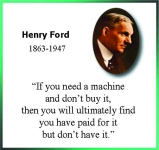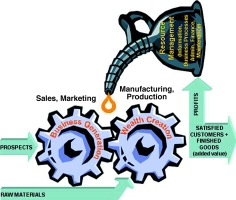

Few dare to venture into what promises to be one of the most exciting developments in the history of business.
The mining and manufacturing industries have been talking about it for some time but seem rather unsure as to what is involved and what it means. Solution vendors have also been talking about it but most from the comforting depths of their proprietary technology bunkers - few dare to venture into what promises to be one of the most exciting developments in the history of business. And what is all the fuss about? Integrating fragmented companies into unified entities - connecting the shop floor to the top floor, eliminating departmental and divisional barriers and providing a seamless information space geared to help companies exceed their business objectives on a routine basis.
Obstacles
This great prize is being defended by some really nasty trolls armed with a full arsenal of doubtful technologies, opinions, egos, private agendas and, the deadliest weapon of all, tradition. But they can be defeated and what follows will help.
Who should read this and why?
This series of articles is primarily aimed at managing directors, financial directors, chief information officers, IT managers, production managers and engineers. That is because enterprise integration is a top down thing, although it will need the buy-in of everyone it will affect. This should also be read by anyone who is keen on making things go right for their companies.
The reason why this series of articles should be read is very simple: it will help put business and operational processes in the proper perspective for integration to happen. It highlights some of the problems and suggests some solutions. It also cuts through the maze of complexities companies find themselves in today by highlighting what really matters. And finally, this should be read because it sells nothing but common sense - no revolutionary new approaches, no snappy three-letter acronyms and no proprietary technologies. Enterprise integration is not something you buy - it is something you do.
What is enterprise integration trying to fix?
The objective of enterprise integration is seamless, right-time decision support throughout the organisation. The strategies of the top floor need to be made within the constraints of the shop floor. Costing needs to look at overheads as well as benefits (today we only measure overheads because we cannot/do not measure benefits, but more about this later). These and hundreds more issues need a seamless interconnection of information flows that transcend traditional boundaries. This information also needs to be available at the right time if it is to be useful. On the shop floor, the time scale is that of realtime (as it happens). In admin, the time scale could be days, weeks or even months. But it is all information and it is all interrelated. Today, it is also what the business depends on for profitable survival.
As the worlds of plant automation and business systems start to overlap, the functionality offered by the automation and plant information systems vendors is becoming more relevant than ever. But it seems that few CIOs and IT managers realise this as they still look to traditional suppliers for business solutions that are inherently disconnected from the plant floor or have poor interfaces to production systems.
From admin to manufacturing, information is the common denominator of every function within the organisation. If everyone got the right information when they needed it, they would be able to make better decisions and cooperate better with their colleagues to the benefit of the company. This is obvious but what is not at all obvious is how to actually make it all work.
True perspective
IT has often been regarded as the hub of the company (especially by IT managers) - but there again, so has finance (according to financial directors) and manufacturing (according to production managers) - if you are a hammer, everything looks like a nail. It is time to put things in perspective.
For the past 50 years, manufacturing companies have been bombarded with torrents of opinions as to what they should do and how they should do it. No sooner had one acronym been implemented than another popped out of the woodwork stating that whatever preceded it was 'old hat' and that this was the new way forward. Perhaps the time has come to return to basics and to put aside (at least for the moment) the 'baggage' of the past.
One thing we know how to do is make machines and what is a manufacturing company if not a machine for turning prospects into customers and raw materials into finished goods. A by-product of these activities is profit. It is important to note that machines are coordinated, single-minded entities free from internal politics and hopefully free from illogical design. Therefore the analogy of a smoothly-running machine seems a good one for the unified enterprise of the 21st century. For a machine to operate properly, the following must be addressed:
1. What the machine is supposed to achieve (ie, competitive and quality finished goods, create a market, return a profit, etc) - addressed in Part 1 of this series of articles.
2. A design that will make the machine achieve its purpose - see Part 2 for a suggested company structure that focuses on achieving the company's objective.
3. Reconciling the different needs of the machine's fast and slow-moving parts - see Part 3 on how to reconcile the information needs of manufacturing, production and business systems.
4. Adding mechanisms that help the machine deal with outside demands while making the most of available performance - see Part 4 where manufacturing execution systems (MES) are the key to reconciling business strategy with the realities of shop floor capacity.
5. Measuring the machine's performance and operational parameters - see Part 5 where the concept of dynamic performance management extends status and performance measurement to every part of the enterprise.
What is it all about?
Contrary to popular belief (and with the exception of mints), companies are not created to make money. They are formed in order to sell added value and that is where the money comes from.
Henry Ford did not wake up one morning and shout: 'I know! I will make money!' before rushing out to do - what exactly? Give that guy Kellogg some competition? There are over 21 million references to Henry Ford on the Internet and they all acknowledge his contributions to mass production techniques rather than his financial wizardry. Henry Ford's insistence that the company's future lay in the production of affordable cars for a mass market caused increasing friction between him and the other investors. He eventually got majority shareholding in the company and the rest is memorable history. And that is another thing about companies: they are usually formed to exercise the talents of their creators.
Figure 1 shows a simplistic view of a manufacturing company. The business generation process (sales and marketing) turns prospects into customers for the goods manufactured by the company's wealth-creation process, which transforms raw materials into finished goods (added value). The Boeing Aircraft Company, for example, sells aircraft to the world's airlines and adds value to aluminium by making it fly predictably for them. Everything else (resource management - functions that all companies do) is in support of these two vital processes, which are unique to each company and which characterise them to the outside world. None of these three elements (business generation, wealth creation and resource management) can operate independently from the other two. So, thinking that IT, finance or anything else is somehow senior to something else is simply dangerous wishful thinking.

If viewed in this way, the company (but not its personnel) becomes a mechanism or machine for creating wealth through a process of selling added value to customers. Now, from toasters to communication satellites, we really know how to make machines work and, in the end, that is what enterprise integration is all about - applying what we know about making machines work to companies.
In this day and age, the fragmentation of companies into autonomous mini empires under the control of budding megalomaniacs is no longer tenable. Grouping things under headings like enterprise resource planning or manufacturing execution systems is great as long as these terms are used to describe sets of functions rather than to divide companies into factions or place boundaries where there should be none. And terms like 'division' or 'department' do not help either. The functions that a company carries out in order to achieve its objectives are all interconnected to a greater or lesser degree. It is enterprise integration rather than the king's men that will put Humpty Dumpty together again.
In Part 2, we will take another look at the company structure as well as the nature of the various sources of information in a manufacturing company and how they can be reconciled.
For more information contact Justin Tweedie, Futuristix, 0861 WONDER (0861 966 337), [email protected], www.futuristix.co.za
The scope of enterprise integration is more than getting shop floor systems, manufacturing execution systems and enterprise resource planning systems talking to one another. An integrated information environment is going to trigger changes in everything from accounting to accountability. And that is where the real benefits lie.

© Technews Publishing (Pty) Ltd | All Rights Reserved